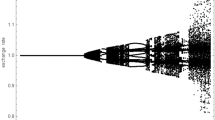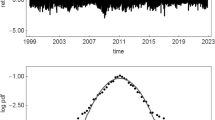Abstract
This article generalizes the results shown in De Grauwe, Dewachter, and Embrechts (1993) in a more sophisticated framework. In their model, the speculative dynamics resulting from the interaction between chartists and fundamentalists are incorporated into a Dornbusch-style model to generate a chaotic nominal exchange rate. Here the model of Obstfeld and Rogoff (1995, 1996) replaces the Dornbusch model, and chaotic solutions are still shown to be possible for sensible parameter values.
Similar content being viewed by others
References
Da Silva, Sergio (1998) “Exchange Rate Models, Chaos, and Foreign Exchange Intervention.” Ph.D. Thesis, Department of Economics, Birmingham University, unpublished.
—— (2000) “The Role of Foreign Exchange Intervention in a Chaotic Dornbusch Model.” Kredit und Kapital 33(3):309–345.
De Grauwe, Paul (1996) International Money: Postwar Trends and Theories, 2nd ed. Oxford: Oxford University Press.
De Grauwe, Paul and Hans Dewachter (1992) “Chaos in the Dornbusch Model of the Exchange Rate.” Kredit und Kapital 25(1):26–54.
De Grauwe, Paul, Hans Dewachter and Mark Embrechts (1993) Exchange Rate Theory: Chaotic Models of Foreign Exchange Markets. Oxford and Cambridge, MA: Blackwell.
Dornbusch, Rudiger (1976) “Expectations and Exchange Rate Dynamics.” Journal of Political Economy 84(6):1161–1176.
Fender, John and Chong K. Yip (2000) “Tariffs and Exchange Rate Dynamics Redux.” Journal of International Money and Finance 19(5):633–655.
LeBaron, Blake (1994) “Chaos and Nonlinear Forecastability in Economics and Finance.” Philosophical Transactions of the Royal Society of London A 348(1686):397–404.
—— (1996) “Technical Trading Rule Profitability and Foreign Exchange Intervention.”Working Paper, No. 5505, March, NBER, Cambridge, MA.
Obstfeld, Maurice and Kenneth Rogoff (1995) “Exchange Rate Dynamics Redux.” Journal of Political Economy 103(3):624–660.
—— (1996) Foundations of International Macroeconomics. Cambridge, MA and London: The MIT Press.
Silber, William L. (1994) “Technical Trading: When It Works and When It Doesn't.” The Chartered Financial Analyst Digest 24(3):66–68.
Sprott, J. Clint (1995) Chaos Data Analyzer: The Professional Version 2.1. University of Wisconsin, Madison, WI 53706.
Sprott, J. Clint and George Rowlands (1995) PC User's Manual of Chaos Data Analyzer: The Professional Version. New York: American Institute of Physics.
Stewart, Ian (1997) Does God Play Dice? The New Mathematics of Chaos, 2nd ed. London: Penguin Books.
Szpiro, George G. (1994) “Exchange Rate Speculation and Chaos Inducing Intervention.” Journal of Economic Behavior and Organization 24(3):363–368.
Author information
Authors and Affiliations
Rights and permissions
About this article
Cite this article
Da Silva, S. Chaotic Exchange Rate Dynamics Redux. Open Economies Review 12, 281–304 (2001). https://doi.org/10.1023/A:1011181423098
Issue Date:
DOI: https://doi.org/10.1023/A:1011181423098




